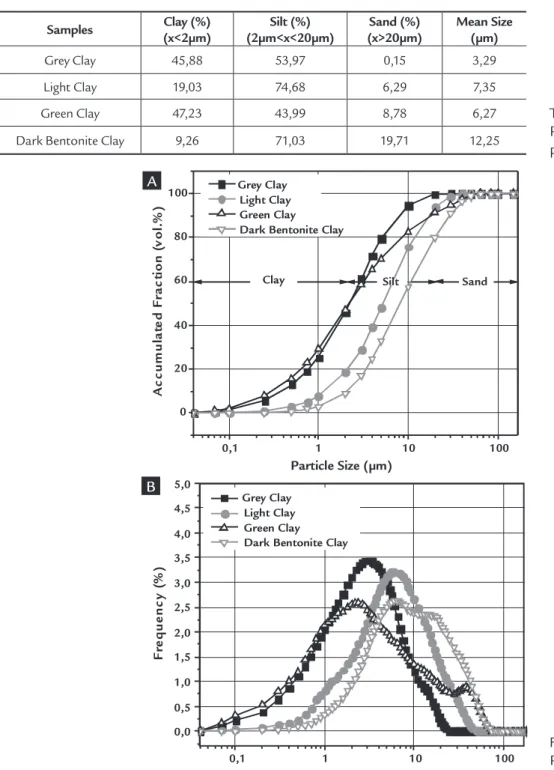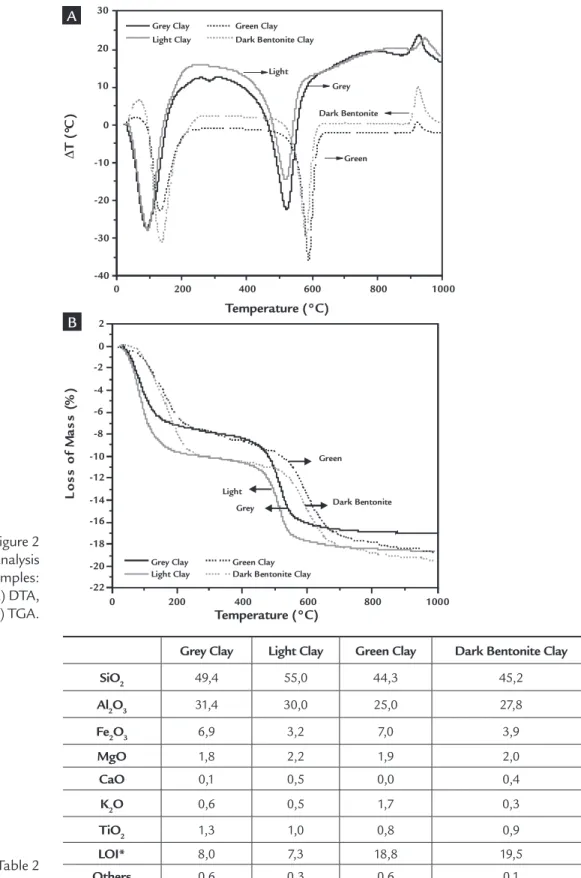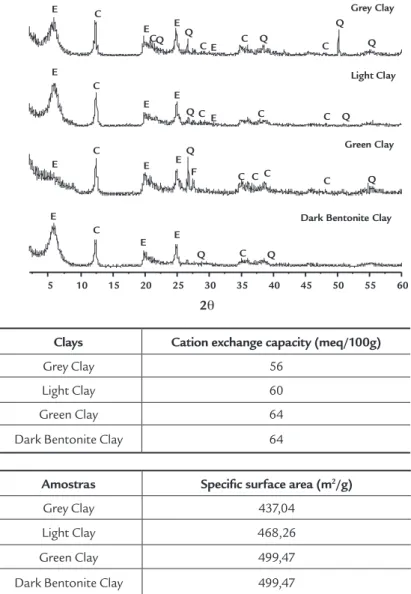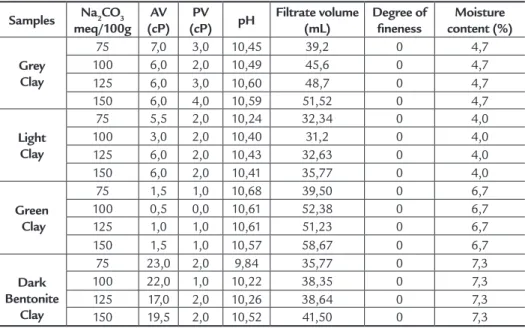485
Resumo
Recentemente foram descobertos novos depósitos de argilas bentoníticas no Estado da Paraíba principalmente nos municípios de Cubati e Pedra Lavrada, criando uma grande expectativa pela possibilidade de ampliação das novas reservas para produção industrial. O objetivo desse trabalho foi estudar as novas ocorrências de argilas bentoníticas da Paraíba, principalmente do município de Pedra Lavrada, para uso em luidos de perfuração base água. A caracterização mineralógica foi efetuada através da análise granulométrica por difração de laser, análises termogravimétrica e térmica diferencial, composição química por luorescência de raios X, difração de raios X, capacidade de troca de cátions e área especíica. As argilas bentoníticas foram tratadas com carbonato de sódio nas concentrações de 75, 100,125,150 e 175meq/100g de argila seca, para sua transformação da forma policatiônica para forma sódica. Para caracterização tecnológica, foram confeccionados luidos de perfuração de acordo com as normas da Petrobras. Os resultados obtidos evidenciaram que as amostras estudadas apresentaram, na sua composição mineralógica, montmorilonita, caulinita e quartzo. Em relação às propriedades reológicas, veriicou-se que as amostras estudadas atendem parcialmente aos requisitos reológicos da norma da Petrobras.
Palavras-chave: Argila bentonítica, caracterização, luidos de perfuração.
Abstract
New bentonite clay deposits have recently been discovered in the state of Paraíba, mainly in the municipalities of Cubati and Pedra Lavrada, creating great expectations in view of the possibility of expanding industrial production using these new reserves. The aim of this study was to study the new occurrences of bentonite clay in Paraíba, particularly in the municipality of Pedra Lavrada, for use in water based drilling luids. The mineralogical properties of the clays were characterized by particle size analysis using laser diffraction, and thermogravimetric and differential thermal analysis, and its chemical composition was analyzed by X-ray luorescence, X-ray diffraction, cation exchange capacity and speciic surface area. The bentonite clays were treated with sodium carbonate at concentrations of 75, 100, 125, 150 and 175mEq/100g of dry clay, to transform them from polycationic to sodium form. For the technological characterization, drilling luids were prepared according to the standards of Petrobras. The results indicated that the mineralogical composition of the samples consisted of montmorillonite, kaolinite and quartz. As for their rheological properties, the samples were found to partially meet the rheological requirements of the Petrobras standard.
Keywords:Bentonite clay, characterization, drilling luids. Isabelle A. Silva
Aluna de Pós-Graduação em Ciência e Eng. de Materiais, UFCG. isabelle_albuquerquecg@hotmail.com
Julliana Marques R. Costa Aluna de Pós-Graduação em Ciência e Eng. de Materiais, UFCG. jullymrc@gmail.com
Romualdo R. Menezes Pesquisador Dr.,
Unidade Acadêmica de Eng. de Materiais, UFCG. romualdomenezes@dema.ufcg.edu.br
Heber S. Ferreira Professor Dr.,
Departamento de Eng. de Materiais, UFPB. hebersivini@ig.com.br
Gelmires de A. Neves Professor Dr.,
Unidade Acadêmica de Eng. de Materiais, UFCG. gelmires@dema.ufcg.edu.br
Heber C. Ferreira Professor Dr.,
Unidade Acadêmica de Eng. de Materiais, UFCG. heber@dema.ufcg.edu.br.
Studies of new occurrences of
bentonite clays in the State of
Paraíba for use in water based
drilling luids
Estudos de novas ocorrências de argilas
bentoníticas do Estado da Paraíba para
uso em fluidos de perfuração base água
1. Introduction
The crystalline structure of ben-tonite clays is triple-layered, consisting of two tetrahedral sheets and one octahedral sheet. These tetrahedral and octahedral sheets exhibit isomorphic substitution that produces a charge imbalance, generating a cation-exchange capacity (CEC) in the order of 100mEq/100g of dry clay. This group comprises four dioctahedral and three trioctahedral clay minerals. The dioctahedral clay minerals are beidellite, nontronite, volkonskoite and montmoril-lonite, and the trioctahedral clay miner-als are saponite, sauconite and hectorite (Souza Santos, 1992; Silva and Ferreira, 2008 and 2009).
Bentonite clays are produced by the decomposition of volcanic ash in alkaline environments with restricted water circu-lation, and their predominant clay mineral is montmorillonite (Souza Santos, 1992; Silva and Ferreira, 2008 and 2009).
It should be noted that bentonites are composed mainly of the clay min-eral montmorillonite. The complexity of these concepts leads to constant misin-terpretation. To further complicate the issue, Souza Santos (1992) stated that montmorillonite clays used industrially as bentonites, regardless of their geological origin, can be called bentonites. In the same vein, we should mention the work of Golpinath, Schuster and Schuckmann (1981 and 1988), who showed that mont-morillonite clays from the region of the municipality of Boa Vista, state of Paraíba, and surroundings are bentonites. Thus, in
this paper, the clays under study will be referred to as bentonites.
Bentonite may be calcium or so-dium bentonite, and in its soso-dium form it presents a very particular physical char-acteristic, i.e., its volume expands many times over when in contact with water, forming thixotropic gels (Souza Santos, 1992; Bernier et al., 2003; Sousa, 2010; Menezes et al., 2008).
Bentonite is used industrially for various purposes, e.g., as a viscosity modi-ier of oil drilling luids, as a sand casting binder, as an iron ore pelletizer, in sanitary napkins for pets, and as an oil bleacher, among others uses (Caenn and Chillingar, 1996; Mahto and Sharma, 2004; Amorim et al., 2002; Coelho and Souza Santos, 2007; Campos 2007; Menezes et al., 2009; Menezes et al., 2010).
Several researchers of the Academic Unit of Materials Engineering at the Federal University of Campina Grande – UFCG, Brazil have been conducting research into the use of bentonite clay in oil drilling luids. These studies include that of Amorim (2003), who worked on samples of natural bentonite clays and industrialized sodium clays from deposits in Boa Vista, PB, aiming to improve their rheological behavior and obtain contami-nation resistant water and clay-based lu-ids. The results indicated that the different behaviors presented by dispersions, after protection and recovery treatments, can be very useful to optimize the application of these clays in drilling luids.
Campos (2007) studied composi-tions of bentonite clays in deposits in the municipality of Boa Vista, PB, aim-ing to potentiate the utilization of poor quality clays in oil drilling luids. The results conirmed that studies of clay compositions can be very useful for the clay miners and beneiciation industry of Boa Vista, as well as for the crude oil sector, given the possibility of using poor quality clay, which is available in large quantities in bentonite deposits, in oil drilling luids.
Sousa (2010) studied compositions of organophilic clays for organic based drilling luids containing the following additives: dispersants, emulsiiers, brine, activator, iltrate reducer, and densiiers, in order to evaluate their rheological be-havior, iltration and electrical stability. The results demonstrated that two of the developed compositions show a promis-ing potential that meets the speciications of Petrobras.
Ferreira (2009) studied the organo-philization of bentonite clays from Boa Vista, PB, for use as viscosity modiiers of oil-based drilling luids. His indings indicated the importance of process vari-ables to the organophilization process and the rheology of dispersions for use in drilling luids.
The objective of this work was to study the new occurrences of bentonite clays in the municipality of Pedra Lavrada, state of Paraíba, Brazil, for use in water based drilling luids.
2. Materials and methods
Materials
The following clay samples were
used: Grey Clay, Light Clay, Green Clay and Dark Bentonite Clay, from deposits located in the municipality of Pedra Lavrada, PB.
Methods
The samples were dried at room temperature for approximately four days, after which they were milled in a ball mill lined with a very hard ceramic material. The milled materials were then sifted through an electric sieve (Pavit-est I-3007) (0.074 mm sieve opening). Aliquots of the sifted materials were removed for the various physical, chemi-cal, and mineralogical characterizations, and to test their use in water based drill-ing luids.
The clays were characterized using the following techniques: laser diffraction particle size analysis (CILAS 1064 L/D particle size analyzer); thermogravimetric analysis (TGA) and differential thermal analysis (DTA) (BP Eng. Ind. e Com. Model RB 3020 thermal analyzer); chemi-cal composition by X-ray luorescence (EDX) equipment (Shimadzu EDX-720 fluorescence spectrometer), X-ray dif-fraction (Shimadzu XRD-6000 X-ray diffractometer); cation exchange capacity
(CEC) and speciic surface area (SSA) (us-ing the methylene blue adsorption method described by Chen et al., 1974).
487 The rheological properties of apparent
viscosity (AV) and plastic viscosity (PV) were determined, using a Fann 35A
vis-cometer. Filtrate volume was determined by iltration through a Fann ilter press, and pH in a Hanna electronic pH meter.
All the tests were performed according to the Petrobras EP-1EP-00011-A standard (2011).
3. Results and discussion
Table 1 and Figure 1 describe the particle size distribution of the clays under study, whose distribution curve is monomodal (Gray and Light Clays) or bimodal (Green Clay and Dark Ben-tonite). The latter show a concentration of particles between 2 and 9 µm, with a mean diameter smaller than 3.29 µm for the Grey Clay and larger than 12.25 µm for the Dark Bentonite.
In addition, a high cumulative
vol-ume percentage was found to have a mean diameter smaller than 2.0 μm, which was equivalent to 47.0% for the Green Clay (corresponding to the clay fraction) and to only 9.0% for the Dark Bentonite Clay. In terms of accumulated volume of silt (par-ticle diameter larger than 2μm and smaller than 20μm), the Light and Dark Bentonite clays showed values above 71.0%, while the Green and Gray clays showed lower values of 44.0% and 54.0%, respectively.
A comparison of the particle size distribution reported by Ferreira (2009) for Chocolate Bentonite clays from Boa Vista, PB, and the Light clay from Pedra Lavrada,PB, reveals very similar results, thus indicating that the physical charac-teristics of this sample will probably be similar to those of the bentonites from Boa Vista, PB.
Figure 2 shows the TGA and DTA curves of the clays of this study. An
Samples Clay (%) (x<2µm)
Silt (%) (2µm<x<20µm)
Sand (%) (x>20µm)
Mean Size (µm)
Grey Clay 45,88 53,97 0,15 3,29
Light Clay 19,03 74,68 6,29 7,35
Green Clay 47,23 43,99 8,78 6,27
Dark Bentonite Clay 9,26 71,03 19,71 12,25
Table 1
Particle size distribution and average particle diameter of the samples.
Figure 1
Particle size distribution of the clays: cumulative volume (A), histogram (B).
0,1 1 10 100
0 20 40 60 80
100 Grey Clay Light Clay Green Clay Dark Bentonite Clay
0,1 1 10 100
0,0 0,5 1,0 1,5 2,0 2,5 3,0 3,5 4,0 4,5 5,0
Grey Clay Light Clay Green Clay Dark Bentonite Clay
Sand Silt
Clay
Particle Size (µm)
Particle Size (µm)
F
re
q
u
e
n
c
y
(
%
)
A
c
c
u
m
u
la
te
d
F
ra
c
ti
o
n
(
v
o
l.
%
)
A
analysis of the curves in Figure 2A reveals the following thermal transformations: an endothermic peak at around 150ºC, characterizing the presence of free and adsorbed water; an exothermic band be-tween 200 and 500ºC, corresponding to the combustion of organic matter (in the Gray and Light clays); an endothermic peak at around 520ºC, characterizing the presence of hydroxyls and an exothermic
peak at around 930ºC, characterizing the nucleation of mullite due to the high kaolinite content, as will be seen in the XRD tests. The TGA curves in Figure 2B indicate total mass losses of 17.6%, 19.2%, 18.8% and 19.5%, respectively, which correspond to losses in water, or-ganic matter and hydroxyls. A comparison of the results of our thermogravimetric analysis with those reported by Menezes
et al. (2009) for bentonites from Cubati, PB shows that they are similar.
Table 2 presents the chemical com-positions of the samples under study. An analysis of the results in Table 2 indicates that the clays had high SiO2 (> 45%) and Al2O3 (> 25%) contents. The Gray and Green Clays presented 6.9% and 7.0% of Fe2O3 content, respectively, while that of the other clays was lower than 5.0%.
Figure 2 Thermal analysis
of the samples: A) DTA, B) TGA.
Table 2 Chemical composition of the samples under study.
Grey Clay Light Clay Green Clay Dark Bentonite Clay SiO2 49,4 55,0 44,3 45,2
Al2O3 31,4 30,0 25,0 27,8
Fe2O3 6,9 3,2 7,0 3,9
MgO 1,8 2,2 1,9 2,0
CaO 0,1 0,5 0,0 0,4
K2O 0,6 0,5 1,7 0,3
TiO2 1,3 1,0 0,8 0,9
LOI* 8,0 7,3 18,8 19,5
Others 0,6 0,3 0,6 0,1
*LOI – Loss on Ignition
0 200 400 600 800 1000
-40 -30 -20 -10 0 10 20 30
Light
Grey Green
Temperature (°C)
Temperature (°C)
L
o
s
s
o
f
M
a
s
s
(
%
)
Δ
T
(
°C
)
Grey Clay Green Clay Light Clay Dark Bentonite Clay
Dark Bentonite
0 200 400 600 800 1000
-22 -20 -18 -16 -14 -12 -10 -8 -6 -4 -2 0 2
Grey Clay Green Clay Light Clay Dark Bentonite Clay
Green Dark Bentonite Grey
Light
A
489 According to Amorim (2003), an iron
content of about 7.0% is typical of clays from the municipality of Boa Vista, PB. Souza Santos (1992) stated that these iron contents come from bentonite containing about 4.0 to 6.0% of Fe2O3. The K2O and TiO2 contents were relatively low, i.e., lower than 2%. Comparing the values reported by Amorim (2003) and Souza Santos (1992), we found that the chemi-cal composition of the clays is typichemi-cal of bentonite clays.
Figure 3 presents the XRD results of the clays studied here. Figure 3 shows that the samples presented the following mineral phases: smectites (montmoril-lonite), characterized by 15.201Å, 4.48Å and 3.050Å; kaolinite, characterized by interplanar distances of 7.15Å, 3.566Å, 3.365Å, 2.553Å, 2.331Å and 1.892Å; and quartz, characterized by 4.26Å, 2.166Å, 1.817Å and 1.672Å. The presence of smec-tite (montmorillonite) was conirmed by testing with ethylene glycol (Souza Santos, 1992). Thus, it can be stated that, in gen-eral, these clays contain large quantities of kaolinite. The Dark Bentonite clay sample
showed a slightly lower kaolinite content, which may favor its rheological behavior.
According to Menezes et al. (2009), bentonite clays from the municipality of Cubati, PB present the following mineral phases: montmorillonite, kaolinite and quartz, and are similar to the clays from the municipality of Pedra Lavrada. In general, the Grey, Light, Green and Dark Bentonite clays presented XRD patterns typical of bentonite clays with high kaolinite contents (Souza Santos, 1992; Ferreira, 2009).
Table 3 describes the cation ex-change capacity (CEC) of the samples under study, which was determined by the methylene blue method. As can be seen in Table 3, the CEC values of the samples were very similar, except for the Grey clay sample, and were lower than the level of montmorillonite clay mineral in the smectite group due to their high kaolinite content (80 to 150mEq/100g) (Souza San-tos, 1992). However, compared with the clays from the municipality of Boa Vista, PB, whose CEC is 56 meq/100g, according to Ferreira (2009), the results of this study
were very similar, i.e., CEC values of 60 to 64 mEq/100 g.
Table 4 shows the results of the speciic surface area of the samples. In Table 4, note that the speciic surface area of all the samples exhibited higher values than those of the montmorillonite clays studied by Ferreira (2009). According to Ferreira (2009), the speciic surface area of chocolate type smectite clays from the municipality of Boa Vista, PB, is 437.04 m2/g. Comparing this value with that of the clays in the municipality of Pedra Lavrada, PB, one inds that the Green and Dark Bentonite clays possess higher values of speciic surface area.
Table 5 shows the apparent vis-cosity (AV), plastic visvis-cosity (PV), pH, iltrate volume, degree of ineness and moisture content of the clay samples. As can be seen in Table 5, the Dark Bentonite showed best results of apparent viscosity (AV), with values of 23 cP, 22 cP and 19.5 cP for contents of 75, 100 and 150 mEq/100g of dry clay. A comparison of these values with the Petrobras standards (2011) indicates that the AV is higher
Figure 3
X-ray diffractograms of the clays.
Table 3
Cation exchange capacity of the samples.
Clays Cation exchange capacity (meq/100g)
Grey Clay 56
Light Clay 60
Green Clay 64
Dark Bentonite Clay 64
Amostras Speciic surface area (m2/g)
Grey Clay 437,04
Light Clay 468,26
Green Clay 499,47
Dark Bentonite Clay 499,47 Table 4
Speciic surface area of the samples. Q
E
E C
E Q
C C Q
C Q
Q C E
Grey Clay
E Light Clay
C
E
Q C E C C Q
E
5 10 15 20 25 30 35 40 45 50 55 60
Green Clay
F E E
C E
Q
C C C C Q
E Dark Bentonite Clay
C
E E
Q C Q
than the minimum speciied apparent viscosity of 15.0 cP. As for plastic viscos-ity (PV), which, according to Petrobras speciications (2011) cannot be lower than 4.0 cP, the Grey clay presented the best results, i.e., a concentration of 150 mEq/100g. In terms of pH, all the clays are very close to Petrobras speciications (2011) which require a maximum of pH 10.0. The iltrate volume exceeded the 18.0 mL speciied by the Petrobras standards (2011).
After sifting the samples though an ABNT # 200 mesh sieve (0.074 mm), the sieve residue was lower than the maximum of 4.0% speciied by Petrobras. The mois-ture content of the clays was lower than the maximum of 14.0% required by the speciications. An overall analysis of the results indicated that none of the samples meets the requirements of Petrobras (2011), and that the dark bentonite clay presented the best results. However, the results of all the samples need to be studied
in greater depth, particularly with respect to their rheological properties with addi-tives. According to the studies of Amorim (2003), encouraging results have shown that, with industrial additives, it is likely that suitable responses can be obtained for clay dispersions in the locculated gel state, which is the case of Dark Bentonite, with an increase in apparent and plastic viscosity and reduction of the iltrate vol-ume, in order to meet the requirements of the standard.
Table 5 Apparent viscosity (AV), plastic viscosity
(PV), iltrate volume, degree of ineness and moisture content of the samples.
Samples Na2CO3
meq/100g AV (cP)
PV (cP) pH
Filtrate volume (mL)
Degree of ineness
Moisture content (%) Grey
Clay
75 7,0 3,0 10,45 39,2 0 4,7
100 6,0 2,0 10,49 45,6 0 4,7
125 6,0 3,0 10,60 48,7 0 4,7
150 6,0 4,0 10,59 51,52 0 4,7
Light Clay
75 5,5 2,0 10,24 32,34 0 4,0
100 3,0 2,0 10,40 31,2 0 4,0
125 6,0 2,0 10,43 32,63 0 4,0
150 6,0 2,0 10,41 35,77 0 4,0
Green Clay
75 1,5 1,0 10,68 39,50 0 6,7
100 0,5 0,0 10,61 52,38 0 6,7
125 1,0 1,0 10,61 51,23 0 6,7
150 1,5 1,0 10,57 58,67 0 6,7
Dark Bentonite
Clay
75 23,0 2,0 9,84 35,77 0 7,3
100 22,0 1,0 10,22 38,35 0 7,3
125 17,0 2,0 10,26 38,64 0 7,3
150 19,5 2,0 10,52 41,50 0 7,3
4. Conclusões
Based on this study of new occur-rences of smectite clays in the municipality of Pedra Lavrada, PB for possible applica-tion in water based drilling luids, it was
concluded that the samples presented a mineral composition of montmorillonite, kaolinite and quartz. As for their rheologi-cal properties, the samples partially meet
the speciications of Petrobras standards (2011) for use in water based drilling luids, and the Dark Bentonite Clay was found to be the most promising sample.
5. Referências bibliográicas
AMORIM, L. V., GOMES, C. M., SILVA, F. L. H., FERREIRA H. C. Comportamento reológico de dispersões de argilas bentoníticas: efeitos do tipo de ferramenta, velocidade e tempo de agitação.Cerâmica, v. 48, n. 308, p.75-85, 2002.
AMORIM, L. V. Melhoria, proteção e recuperação da reologia de luidos hidroargilosos para uso na perfuração de poços de petróleo. Campina Grande, PB: Curso de Engenharia de Processos/CCT/UFCG, 2003. (Tese de Doutorado).
BERNIER, R., GARLAND, E., GLICKMAN, A., JONES, F., MAIRS, H., MELTON, R., RAY, J., SMITH, J., THOMAS, D., CAMPBELL, J. Environmental aspects of the use and disposal of non aqueous drilling luids associated with offshore oil & gas operations. International Association of Oil & Gas Producers Report, n. 342, Inglaterra, Londres, 2003.
CAMPOS, L. F. A. Composições de argilas bentoníticas para utilização em luidos de perfuração de poços de petróleo. Campina Grande, PB: Curso de Engenharia de Processos/CCT/UFCG, 2007. 140f. (Tese de Doutorado).
CAENN, R., CHILLINGAR, G. V. Drilling luids: state of the art. Journal of Petroleum Science and Enginnering, 14, p. 221-230, 1996.
491 COELHO, A. C. V., SOUZA SANTOS, P. Argilas especiais: argilas quimicamente
modiicadas – uma revisão. Quim. Nova, v. 30, n. 5, p.1282-1294, 2007.
FERREIRA, H. S. Otimização do processo de organoilização de bentonitas visando seu uso em luidos de perfuração não aquosos. Campina Grande, PB: UFCG, Engenharia de processos, 2009. (Tese de Doutorado).
GOPINATH, T. R., SCHUSTER, H. D., SCHUCKMANN, W. K. Clay mineralogy and geochemistry of continental bentonite and geological implication Boa Vista, PB. Revista Brasileira de Geociências, v. 18, n. 3, p. 345-352, 1988.
GOPINATH,T. R., SCHUSTER, H. D., SCHUCKMANN, W. K. Modelo de ocorrência e gênese da argila bentonitas de Boa Vista, PB. Revista Brasileira de Geociências, v. 11, n. 3, p. 185-192,1981.
MAHTO, V., SHARMA, V. P. Rheological study of a water based oil well drilling luid. Journal of Petroleum Science and Enginnering, v. 45, p. 123-128, 2004. MENEZES, R. R., MARQUES, L. N., CAMPOS, L. A., FERREIRA, H. S.,
SANTANA, L.N.L., NEVES, G.A. Use of statistical design to study the inluence of CMC on the rheological properties of bentonite dispersions for water-based drilling luids, Applied Clay Science, 2010.
MENEZES, R. R., CAMPOS, L. F. A., FERREIRA, H. S., MARQUES, L. N., NEVES, G. A., FERREIRA, H. C. Estudo do comportamento reológico das argilas bentoníticas de Cubati, Paraíba, Brasil. Cerâmica,55,p.349-355, 2009. MENEZES, R. R., ÁVILA JÚNIOR. M. M., SANTANA, L. N. L., NEVES, G.
A., FERREIRA, H. C. Comportamento de expansão de argilas bentoníticas organofílicas do Estado da Paraíba. Cerâmica, 54, p.152-159, 2008.
PETROBRAS. Viscosiicante para luidos usados na exploração e produção de poços de petróleo e gás. Norma EP-1EP-00011-A, 2011.
SILVA, A. R. V., FERREIRA, H. C. Argilas bentoníticas: conceitos, estruturas, propriedades, usos industriais, reservas, produção e produtores/fornecedores nacionais e internacionais. Revista Eletrônica de Materiais e Processos, v. 3, n. 2, p.26-35, 2008.
SOUSA, F. K. A. Estudo de composições de argilas organofílicas para luidos de perfuração de poços de petróleo em águas ultraprofundas. Campina Grande, PB: Engenharia de Materiais, UFCG, 2010. 180p. (Tese de Doutorado).
SOUZA SANTOS, P. Ciência e tecnologia de argilas. São Paulo: Editora Edgard Blücher, 1992. v. 2, p. 609.



